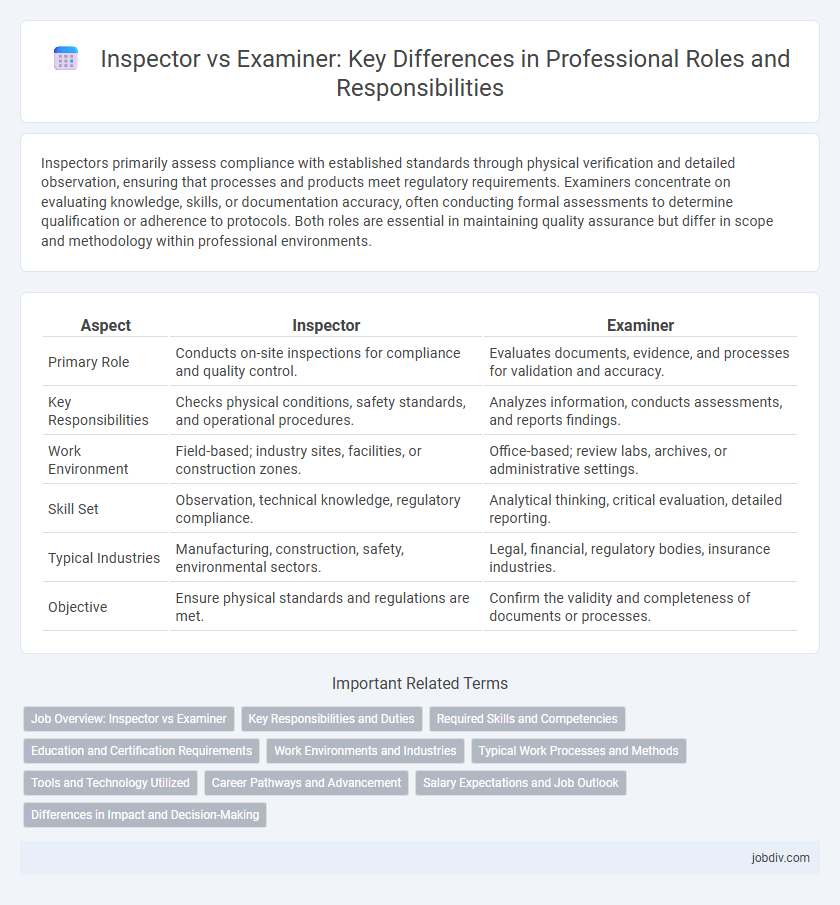Inspectors primarily assess compliance with established standards through physical verification and detailed observation, ensuring that processes and products meet regulatory requirements. Examiners concentrate on evaluating knowledge, skills, or documentation accuracy, often conducting formal assessments to determine qualification or adherence to protocols. Both roles are essential in maintaining quality assurance but differ in scope and methodology within professional environments.
Table of Comparison
| Aspect | Inspector | Examiner |
|---|---|---|
| Primary Role | Conducts on-site inspections for compliance and quality control. | Evaluates documents, evidence, and processes for validation and accuracy. |
| Key Responsibilities | Checks physical conditions, safety standards, and operational procedures. | Analyzes information, conducts assessments, and reports findings. |
| Work Environment | Field-based; industry sites, facilities, or construction zones. | Office-based; review labs, archives, or administrative settings. |
| Skill Set | Observation, technical knowledge, regulatory compliance. | Analytical thinking, critical evaluation, detailed reporting. |
| Typical Industries | Manufacturing, construction, safety, environmental sectors. | Legal, financial, regulatory bodies, insurance industries. |
| Objective | Ensure physical standards and regulations are met. | Confirm the validity and completeness of documents or processes. |
Job Overview: Inspector vs Examiner
Inspectors conduct on-site evaluations to ensure compliance with regulations and standards, often focusing on physical conditions, safety protocols, and operational procedures. Examiners analyze documents, records, or financial data to assess accuracy, detect discrepancies, and verify adherence to policies or laws. Both roles require keen attention to detail but differ in the primary scope of assessment--field inspection versus detailed review.
Key Responsibilities and Duties
Inspectors conduct thorough visual and technical assessments to ensure compliance with industry standards and regulatory requirements, often focusing on identifying defects, safety hazards, or quality issues. Examiners perform detailed evaluations and analysis, interpreting data and documentation to verify accuracy, validate findings, and support decision-making processes in audits or certifications. Both roles require strong attention to detail, but inspectors emphasize on-the-site inspections while examiners concentrate on critical review and assessment of information.
Required Skills and Competencies
Inspectors require strong attention to detail, analytical skills, and proficiency in identifying defects or non-compliance in products or processes. Examiners must possess critical thinking abilities, expertise in regulatory standards, and competence in conducting thorough evaluations or assessments. Both roles demand excellent communication skills and a deep understanding of industry-specific protocols to ensure accuracy and compliance.
Education and Certification Requirements
Inspectors typically require a high school diploma or equivalent, with specialized vocational training or certification relevant to their field, such as the Certified Building Inspector (CBI) for construction professionals. Examiners often need a higher education degree, such as a bachelor's in their discipline, combined with professional certification like the Certified Medical Examiner (CME) or Certified Patent Examiner credentials. Both roles demand ongoing education and adherence to industry-specific certification standards to maintain proficiency and compliance.
Work Environments and Industries
Inspectors typically operate in manufacturing, construction, and quality control environments, ensuring compliance with safety standards and product specifications. Examiners are more common in financial institutions, education, and government agencies, where they analyze documentation, processes, or performances for accuracy and adherence to regulations. Both roles require meticulous attention to detail but differ in industry focus and the nature of their evaluations.
Typical Work Processes and Methods
Inspectors conduct systematic evaluations by performing visual assessments, measurements, and compliance checks following standardized protocols to ensure products or processes meet specified criteria. Examiners analyze complex data sets, interpret results, and apply specialized tests to identify defects, discrepancies, or regulatory adherence within detailed technical frameworks. Both roles utilize industry-specific tools and documentation methods, with inspectors emphasizing hands-on inspection routines and examiners focusing on analytical review and validation techniques.
Tools and Technology Utilized
Inspectors primarily utilize handheld tools, digital cameras, and mobile inspection software to document physical conditions and ensure compliance with industry standards. Examiners rely on specialized technologies such as forensic analysis software, advanced imaging systems, and data analytics platforms to conduct in-depth evaluations and verify authenticity or accuracy. The integration of AI-driven tools and cloud-based databases enhances both roles, facilitating precise, real-time decision-making in complex professional environments.
Career Pathways and Advancement
Inspectors typically start their careers in entry-level roles involving routine inspections and compliance checks, progressing to senior inspector or supervisory positions with experience. Examiners often require specialized knowledge or certifications, advancing through roles that demand detailed analysis and decision-making, such as lead examiner or quality assurance manager. Career advancement for both paths depends on acquiring industry-specific credentials, gaining technical expertise, and demonstrating leadership skills in regulatory or operational environments.
Salary Expectations and Job Outlook
Inspectors typically earn an average salary ranging from $45,000 to $60,000 annually, depending on industry and experience, while examiners often command higher pay, averaging between $60,000 and $80,000 per year due to specialized skills. Job outlook for inspectors shows steady growth around 5% through 2031, driven by regulatory compliance and quality control needs. Examiners face a slightly stronger demand increase at approximately 7%, especially in finance and government sectors, reflecting the rising complexity of risk assessment and auditing functions.
Differences in Impact and Decision-Making
Inspectors primarily focus on detecting defects and ensuring compliance with established standards, which directly impacts operational quality and safety protocols. Examiners evaluate evidence or documents to determine validity and make informed judgments, influencing regulatory approvals and legal outcomes. Decision-making by inspectors is often immediate and field-based, while examiners rely on detailed analysis and interpretation, affecting the scope and implications of their conclusions.
Inspector vs Examiner Infographic

 jobdiv.com
jobdiv.com